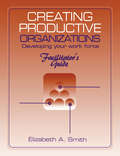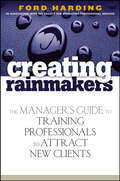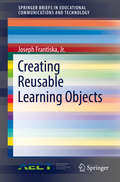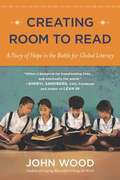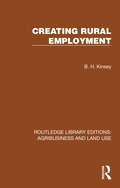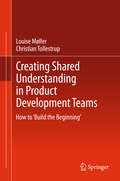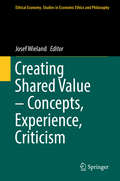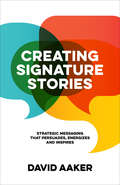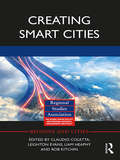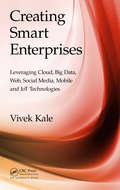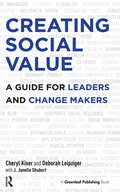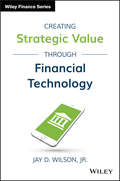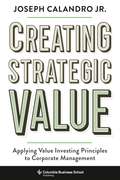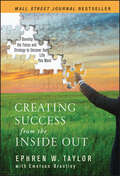- Table View
- List View
Creating Policy Space in Low-Income Countries during the Recent Crises
by Nkunde Mwase Pritha Mitra Yongzheng Yang Paolo Dudine Eteri Kvintradze Sibabrata DasA report from the International Monetary Fund.
Creating Powerful Brands: The Strategic Route To Success In Consumer, Industrial And Service Markets (Cim Professional Ser.)
by Leslie de ChernatonyThis has long been the one book that students can rely on to get them thinking critically and strategically about branding. This new fourth edition is no exception. THE definitive introductory textbook for this crucial topic, it is highly illustrated and comes packed with over 50 brand-new, real examples of influential marketing campaigns. Bullets:• Summarises the latest thinking and best practice in the domain of branding• All new real marketing campaigns show how branding theories are implemented in practice• Brought right up to date with a clear European and UK focusUndergraduate business and marketing students studying brand management will find this an invaluable resource in their quest to understand how branding really works.
Creating Productive Organizations: Manual and Facilitator's Guide
by Elizabeth A. SmithCreating Productive Organizations is an interactive manual that challenges and encourages readers to assess and develop a clear vision of their areas of competence and interest in order to enhance productivity. This facilitator's guide offers solutions and addresses the challenges associated with motivating team members.
Creating Project Plans to Focus Product Development
by Kim B. Clark Steven C. WheelwrightThe long-term competitiveness of most manufacturers depends on their product development capabilities. Yet most companies' development process is unruly and unfocused, with a collection of projects that do not match business objectives and consume far more development resources than are available. An "aggregate project plan" can help managers to focus on a set of projects, rather than individual ones. A central element of the plan is the project map, which categorizes projects into five types: breakthrough, platform, derivative, R&D, and partnerships. With the plan, managers can improve resource allocation, project sequencing, and critical development capabilities.
Creating Rainmakers: The Manager's Guide to Training Professionals to Attract New Clients
by Ford HardingEvery manager of a professional firm realizes that generating leads and landing new clients are critical components of any successful business venture. But transforming accountants, architects, attorneys, consultants, engineers, and other professionals into client-generators is not always easy to do. Divided into two comprehensive parts-The Rainmaker Model and The Elements of Rainmaking-Creating Rainmakers outlines all the steps you should take to turn your professional staff into a powerful team of sales winners. Filled with in-depth insight and practical advice, this book will show you how to: * Generate leads * Build a strong network of contacts * Master a variety of sales techniques * Develop capable successors to current rainmakers * And much more Based on more than 100 interviews with the principals of professional firms, including many of today's preeminent rainmakers, this valuable guide has the information you need to help your company succeed.
Creating Responsible and Inclusive Fashion Brand Narratives: Theory and Practice
by Emily HuggardThis book introduces the theories and frameworks necessary to drive meaningful social change in fashion brand communication, illustrating their applications with examples of brands that prioritize social justice, decolonization, and environmental sustainability in their practices and communication strategies.Drawing on social, consumer, and cultural theories—such as Indigenous dress theory, circularity, fat liberation, and social reproduction—this book encourages students to think critically about brand communication in ways that are relevant, impactful, and aimed at transforming discourse and ideologies, rather than focusing solely on products.Through case studies ranging from Polo Ralph Lauren’s collaboration with Indigenous weaver Naiomi Glasses to material regeneration at Veja, the authors demonstrate how these narratives can be applied in practice while raising ethical questions about transparency and authenticity in fashion brand messaging. Readers will not only gain an understanding of why more inclusive and equitable brand narratives are essential but also develop the knowledge and critical thinking skills needed to analyze, interpret, and contribute to the ongoing transformation of fashion brand storytelling.Creating Responsible and Inclusive Brand Narratives will be of interest to advanced students of Fashion Communication, Marketing and Brand Management.
Creating Reusable Learning Objects (SpringerBriefs in Educational Communications and Technology)
by Joseph FrantiskaThisbrief examines and explores the reuse of learning objects to enhance students' learning experiences. The author details the difficulties of reusing learning objects, or the Reusability Paradox, and how to create more flexible learning objects. The brief also proposes a methodology to minimize limitations and therefore maximize a learning object's utility across a number of fields.
Creating Reverse Financials and the Assumption Checklist: Executing Specific Growth Opportunities Using Discovery-Driven Planning
by Ian C. Macmillan Rita Gunther McgrathOnce you've framed a growth initiative and determined what is necessary to make it succeed, it's time to turn your attention to what it will require to take the project from an idea to a real growth initiative. This chapter introduces tools that will help you keep a discovery-driven growth plan coherent and connected to reality, including the reverse income statement and reverse balance sheet. This chapter is excerpted from "Discovery-Driven Growth: A Breakthrough Process to Reduce Risk and Seize Opportunity."
Creating Room to Read
by John WoodThe inspirational story of a former Microsoft executive's quest to build libraries around the world and share the love of books What's happened since John Wood left Microsoft to change the world? Just ask six million kids in the poorest regions of Asia and Africa. In 1999, at the age of thirty-five, Wood quit a lucrative career to found the nonprofit Room to Read. Described by the San Francisco Chronicle as "the Andrew Carnegie of the developing world," he strived to bring the lessons of the corporate world to the nonprofit sector--and succeeded spectacularly. In his acclaimed first book, Leaving Microsoft to Change the World, Wood explained his vision and the story of his start-up. Now, he tackles the organization's next steps and its latest challenges--from managing expansion to raising money in a collapsing economy to publishing books for children who literally have no books in their native language. At its heart, Creating Room to Read shares moving stories of the people Room to Read works to help: impoverished children whose schools and villages have been swept away by war or natural disaster and girls whose educations would otherwise be ignored. People at the highest levels of finance, government, and philanthropy will embrace the opportunity to learn Wood's inspiring business model and blueprint for doing good. And general readers will love Creating Room to Read for its spellbinding story of one man's mission to put books within every child's reach.
Creating Rural Employment (Routledge Library Editions: Agribusiness and Land Use #26)
by B. H. KinseyOriginally published in 1987, this book discusses the problem of rural employment in developing countries. It puts forward strategies for action and is intended as an applied development manual to assist those organising rural public works programmes. It draws on the experiences of over 20 countries which have implemented such programmes and it draws out the lessons for developing countries in all continents. It discusses policy making, organisational features of programmes, the need to be realistic in establishing the potential and limitations of programmes and explores the problems of assessing performance.
Creating Sales Stars: A Guide to Managing the Millennials on Your Team
by Stephan Schiffman Gary KrebsEveryone knows about the business potential represented by the huge millennial age group. But how do you manage the next generation millennial sales force required to reach this gigantic market? Meet your new sales force: They love collaboration, live and breathe technology, and happily bring assignments home. They also show up late, resist authority, text their friends in meetings, and job hop like there’s no tomorrow.You can bark orders all you want, but it won’t work with millennials. To get great sales results, you need to let go of old school approaches and learn to speak their language.Creating Sales Stars is your field guide to managing today’s emerging sales professionals. Packed with generational insights and surefire strategies, the book helps you:Create a back bench of future sales leadersFire them up and keep them focused on salesEstablish a fun, meaningful environmentTrain them and retain themApply the right pressureTeach without preachingEnsure they feel valuedMine their tech savvyMillennials crave feedback, flexibility, and opportunities to grow. This frank and incisive book shows how to give them what they need—and achieve the results you want.
Creating Shared Understanding in Product Development Teams: How to ‘Build the Beginning’
by Louise Møller Christian TollestrupDevelopment projects that span different disciplines and groups often face problems in establishing a shared understanding of the project's purpose, deliverables, and direction. Creating Shared Understanding in Product Development Teams: How to 'Build the Beginning' uses research-based cases from TC Electronic, The Red Cross, Daimler AG, and Copenhagen Living Lab to demonstrate one approach to this problem complex. It shows how prototyping specific physical artifacts can function as drivers and focal points for creating the much needed shared understanding. Encompassing both the participant's and the facilitator's point of view, Creating Shared Understanding in Product Development Teams: How to 'Build the Beginning' provides both practical examples and theoretical explanation for the process of creating shared understanding. This book provides a toolbox and a practical guide for planning, executing, and facilitating workshops. The result is a clear outline of how to facilitate the creation of physical artifacts that enables and stimulates communication between team members, users, and stakeholders in order to create shared understanding of projects
Creating Shared Value – Concepts, Experience, Criticism (Ethical Economy #52)
by Josef WielandOver the last years, "Creating Shared Value" has become a much discussed concept in business practice as well as in management theory and especially in the context of corporate social responsibility. This book offers a contribution to the current academic discussions on the well-received article of Michael Porter and Marc Kramer in Harvard Business Review in 2011. In the light of the increasing references to the shared value concept, it develops a critical discussion on its fundamentals and its implications for the relationship between economy and society. By that, the book seeks to shed light on the understanding of the role and the nature of the firm in a globalized economy. The result is a collection of interdisciplinary academic reviews which offer interdisciplinary reflections on "Creating Shared Value" to illuminate theoretical, conceptual and practical challenges of the topic. Within the fields of Business Ethics, Theory of the Firm, Management and Philosophy, researcher, students and practitioners will be given a deeper insight on how to approach to the concept in a conceptional and philosophical way.
Creating Shared Value: Impacts of Nestlé in Moga, India (SpringerBriefs on Case Studies of Sustainable Development)
by Asit K. Biswas Cecilia Tortajada Andrea Biswas-Tortajada Yugal K. Joshi Aishvarya GuptaNestlé's Moga factory was set up in 1961 and comprises of the primary milk collection area for Nestlé's operations. Since its inception in Moga, Nestlé has been working with its milk farmers and ancillary suppliers towards improving quality and productivity. The study presented in this book (carried out by the Third World Centre for Water Management, Mexico) highlights Nestlé's way of doing business through its philosophy of Creating Shared Value (CSV) and how it contributed to the development of the region over the past 50 years through direct and indirect employment, steady income for milk and other suppliers, and technology transfer. The main objective of the study is to learn to what extent has Nestlé contributed to fulfilling the societal aspirations and expectations of the people working in and around its factory in terms of employment generation, poverty alleviation, general improvements in the community's standards of living and environmental conservation. The study also tried to determine to what extent has the company created shared value for itself, milk farmers, ancillary firms, and the community at large. This effort aims at encouraging more research to be carried out to comprehensively and authoritatively look into the impacts private sector can have on and around the area where their factories are located and that way, contribute to our understanding of social-corporate-government interdependency. An important aspect of this pioneering monograph is the methodology that could be used to study how Corporate Social Responsibility (CSR) or Creating Shared Value (CSV) of a large multinational company can be properly monitored and objectively evaluated at a region-specific scale, especially as very few studies of this nature have been carried out anywhere in the world. This definitive book is further enriched by a foreword by Prof. Michael Porter of Harvard Business School and an epilogue by Peter Brabeck-Letmathe and Paul Bulcke, Chairman of the Board and CEO of Nestlé respectively.
Creating Shareholder Value
by Alfred RappaportThe ultimate test of corporate strategy, the only reliable measure, is whether it creates economic value for shareholders. Now, in this substantially revised and updated edition of his 1986 business classic, Creating Shareholder Value, Alfred Rappaport provides managers and investors with the practical tools needed to generate superior returns. After a decade of downsizings frequently blamed on shareholder value decision making, this book presents a new and indepth assessment of the rationale for shareholder value. Further, Rappaport presents provocative new insights on shareholder value applications to: (1) business planning, (2) performance evaluation, (3) executive compensation, (4) mergers and acquisitions, (5) interpreting stock market signals, and (6) organizational implementation. Readers will be particularly interested in Rappaport's answers to three management performance evaluation questions: (1) What is the most appropriate measure of performance? (2) What is the most appropriate target level of performance? and (3) How should rewards be linked to performance? The recent acquisition of Duracell International by Gillette is analyzed in detail, enabling the reader to understand the critical information needed when assessing the risks and rewards of a merger from both sides of the negotiating table. The shareholder value approach presented here has been widely embraced by publicly traded as well as privately held companies worldwide. Brilliant and incisive, this is the one book that should be required reading for managers and investors who want to stay on the cutting edge of success in a highly competitive global economy.
Creating Signature Stories: Strategic Messaging that Persuades, Energizes and Inspires
by David AakerStories are orders of magnitude which are more effective than facts at achieving attention, persuading, being remembered, and inspiring involvement. Signature stories—intriguing, authentic, and involving narratives—apply the power of stories to communicate a strategic message. Marketing professionals, coping with the digital revolution and the need to have their strategic message heard internally and externally, are realizing that a digital strategy revolves around content and that content is stories.Creating Signature Stories shows organizations how to introduce storytelling into their strategic messaging, and guides organizations to find, or even create, signature stories and leverage them over time. With case studies built into every chapter, organizations will realize the power of storytelling to energize readers, gain visibility, persuade audiences, and inspire action.
Creating Smart Cities (Regions and Cities)
by Rob Kitchin Leighton Evans Claudio Coletta Liam HeaphyIn cities around the world, digital technologies are utilized to manage city services and infrastructures, to govern urban life, to solve urban issues and to drive local and regional economies. While "smart city" advocates are keen to promote the benefits of smart urbanism – increased efficiency, sustainability, resilience, competitiveness, safety and security – critics point to the negative effects, such as the production of technocratic governance, the corporatization of urban services, technological lock-ins, privacy harms and vulnerability to cyberattack. This book, through a range of international case studies, suggests social, political and practical interventions that would enable more equitable and just smart cities, reaping the benefits of smart city initiatives while minimizing some of their perils. Included are case studies from Ireland, the United States of America, Colombia, the Netherlands, Singapore, India and the United Kingdom. These chapters discuss a range of issues including political economy, citizenship, standards, testbedding, urban regeneration, ethics, surveillance, privacy and cybersecurity. This book will be of interest to urban policymakers, as well as researchers in Regional Studies and Urban Planning.
Creating Smart Enterprises: Leveraging Cloud, Big Data, Web, Social Media, Mobile and IoT Technologies
by Vivek Kale"Vivek Kale's Creating Smart Enterprises goes smack-dab at the heart of harnessing technology for competing in today's chaotic digital era. Actually, for him, it's SMACT-dab: SMACT (Social media, Mobile, Analytics and big data, Cloud computing, and internet of Things) technologies. This book is required reading for those that want to stay relevant and win, and optional for those that don't." —Peter Fingar, Author of Cognitive Computing and business technology consultant Creating Smart Enterprises unravels the mystery of social media, mobile, analytics and big data, cloud, and Internet of Things (SMACT) computing and explains how it can transform the operating context of business enterprises. It provides a clear understanding of what SMACT really means, what it can do for smart enterprises, and application areas where it is practical to use them. All IT professionals who are involved with any aspect of a SMACT computing project will profit by using this book as a roadmap to make a more meaningful contribution to the success of their computing initiatives. This pragmatic book: Introduces the VUCA (volatility, uncertainty, complexity, and ambiguity) business ecosystem confronted by the businesses today. Describes the challenges of defining business and IT strategies and of aligning them as well as their impact on enterprise governance. Provides a very wide treatment of the various components of SMACT computing, including the Internet of Things (IoT) and its constituting technologies like RFID, wireless networks, sensors, and wireless sensor networks (WSNs). This book addresses the key differentiator of SMACT computing environments and solutions that combine the power of an elastic infrastructure with analytics. The SMACT environment is cloud-based and inherently mobile. Information management processes can analyze and discern recurring patterns in colossal pools of operational and transactional data. Analytics, big data, and IoT computing leverage and transform these data patterns to help create successful, smart enterprises.
Creating Social Value: A Guide for Leaders and Change Makers
by J. Janelle Shubert Deborah Leipziger Cheryl KiserThere is a new business landscape, where companies are increasingly being judged on their ability to generate _social value_. But there is no off-the-shelf solution for the leaders and change makers in this new domain. Creating social value is a journey, and each company must chart its own path through uncertain and complex terrain. We invite you to discover how the entrepreneurial leaders profiled in this book have become trailblazers, using strategy and innovation to generate profits and social value simultaneously.Creating Social Value provides insights into the motivations and preoccupations of groundbreaking entrepreneurial leaders as they look to activate change not just within their companies, but also in their sectors, value chains and even through co-creating partnerships with their competitors. Such change requires fundamentally new styles of leadership and business design where companies seek to be generative rather than extractive.This book also bears witness to the emergence of new language to describe these innovative concepts. Working with and sharing ideas with social entrepreneurs and entrepreneurs inside, the authors became aware of the building blocks of a new lexicon with the power to inspire and positively influence the culture of an organization. Many of the leaders included in this book have driven change by harnessing the power of language to reroute their company’s direction.For example, The Campbell Soup Company has created _destination goals_ to describe the long-term vision of the company to nourish its customers, employees and neighbours. Roshan has worked on _nation building_, creating physical infrastructure in Afghanistan, a country decimated by war. UPS has worked to understand its impact on the planet, building a _materiality matrix_ of the issues that matter to its stakeholders, while working to create a culture that fosters social innovation and seeks to understand _constructive dissatisfaction_. Ford is redefining its mission, imagining a different future in which it provides _mobility solutions_, rather than only manufacturing cars. Ford is working with Toyota to co-create technologies to combat climate change.This book sets out a manifesto for Social Value Creation, which is defined as a strategy that combines a unique set of corporate assets (including innovation capacities, marketing skills, managerial acumen, employee engagement, scale) in collaboration with the assets of other sectors and firms to co-create breakthrough solutions to complex economic, social and environmental issues that impact the sustainability of both business and society. Social innovation differs from corporate responsibility in two significant ways: it is strategic and it leverages a wide range of corporate assets and core competencies.Creating Social Value has been designed as a manual for change. It will be essential reading for business students, entrepreneurs and all of those wishing to effect positive, generative change in larger organizations.
Creating Strategic Awareness
by Robert S. Kaplan David P. NortonWhen a new strategy is being launched, all employees must understand the strategy so that they can find new and better ways to conduct their day-to-day business. This chapter looks at ways in which companies like Nova Scotia Power, Motorola, and Sears have developed communication processes that have created employee knowledge and understanding, effectively aligning employees to corporate strategy.
Creating Strategic Value through Financial Technology
by Jay D. Wilson Jr.Lessons in innovation from key FinTech trends and successes Creating Strategic Value through Financial Technology explores the growing Financial Technology (FinTech) industry to provide insight on how traditional financial institutions and FinTech companies can boost innovation and enhance valuation in a complex regulatory environment. In plumbing the depth and breadth of several niches within in the FinTech sector, author Jay Wilson uncovers key themes that have contributed to the industry's success; in this book, he maps them together to provide useful guideposts for investors, entrepreneurs, and traditional institutions looking to facilitate growth as technology and financial services collide. With an expert's perspective on FinTech history and outlook, certain trends and examples of value-enhancing strategies stand out. FinTech niches covered include: payments, crowdfunding, alternative/marketplace lending, the blockchain, and technology solutions in the context of banking, insurance, and investment companies. There is no denying the growing importance of technology in the financial services industry, and the FinTech sector offers valuable solutions for a diverse array of financial services providers and their customers. This book guides you through several niches of the FinTech sector, and highlights the most important takeaways from recent endeavors. Navigate the financial technology sector Enhance customer and product offerings Improve efficiency and cost structure Enhance profitability and company valuation from the intersection of technology and finance Innovation and customer preference is a key driver of FinTech's growth. Customers are demanding better value and convenience, and the organizations that provide it are reaping the rewards of growth. As financial regulations grow more and more complex, and customers are presented with more and more options, it is becoming imperative for traditional institutions to modernize processes and carve out a place in the future of financial services. Creating Strategic Value through Financial Technology provides a handbook for navigating that space, with practical guidance on how FinTech companies and traditional financial institutions can enhance profitability and valuation from the trends.
Creating Strategic Value: Applying Value Investing Principles to Corporate Management
by Joseph Calandro CalandroThe principles of value investing have resonated with savvy practitioners in the world of finance for a long time. In Creating Strategic Value, Joseph Calandro Jr. explores how the core ideas and methods of value investing can be profitably applied to corporate strategy and management.Calandro builds from an analysis of traditional value investing concepts to their strategic applications. He surveys value investing’s past, present, and future, drawing on influential texts, from Graham and Dodd’s time-tested works to more recent studies, to reveal potent managerial lessons. He explains the theoretical aspects of value investing-consistent approaches to corporate strategy and management and details how they can be successfully employed through practical case studies that demonstrate value realization in action. Calandro analyzes the applicability of key ideas such as the margin-of-safety principle to corporate strategy in a wide range of areas beyond stocks and bonds. He highlights the importance of an “information advantage”—knowing something that a firm’s competitors either do not know or choose to ignore—and explains how corporate managers can apply this key value investing differentiator. Offering expert insight into the use of time-tested value investing principles in new fields, Creating Strategic Value is an important book for corporate strategy and management practitioners at all levels as well as for students and researchers.
Creating Stunning Dashboards with QlikView
by Julian VillafuerteBring real business insights to your company through effective and engaging dashboards in QlikViewAbout This BookBuild outstanding dashboards that respond to your company's information needsPresent the data in efficient and innovative ways to promote insightsUnleash the true power of QlikView by creating engaging visualizationsWho This Book Is ForThis book is focused on QlikView developers with basic knowledge of scripting and layouts who want to improve their designing skills and build effective, eye-catching dashboards that deliver tangible value to their business.What You Will LearnBuild a comprehensive library of QlikView components to speed up your developmentsDefine a practical roadmap that will help you build business-driven dashboardsExplore the most effective and engaging ways to present dataApply the best practices in the field of data visualizationAvoid common pitfalls when creating bar, line and pie chartsCreate robust visualizations such as heat maps, histograms and scatter plotsIn DetailQlikView is one of the most powerful analytical tools in the market. Based on an in-memory associative model, it lets users freely navigate through the data, spot trends and make better decisions. This platform is capable of integrating a wide range of data sources like ERP systems, data warehouses or spreadsheets into a single application in order display dashboards with state-of-the-art visualizations.Creating Stunning Dashboards with QlikView is an easy to follow handbook that guides you through the process of creating an effective and engaging dashboard that delivers tangible value to the business. It starts with the identification of the business needs and the definition of the main KPIs, and takes you all the way to the application rollout.Throughout the book, you will learn how to apply some of the best practices in the field of data visualization, create a robust navigation schema, chose the best chart types for each scenario and many other things that will help you create effective dashboards that uncover all the stories behind the data.Style and approachThis easy-to-follow compilation of best practices, tips, and tricks will help you leverage your QlikView developments. Each section presents practical guidelines to help you create dashboards that are not only functional, but also engaging and compelling.
Creating Success from the Inside Out
by Ephren W. Taylor Emerson BrantleyCreating Success from the Inside Out shares the inspiring and motivational story of Ephren Taylor, one of the world's youngest-ever CEOs of a publicly traded company. A millionaire by the young age of sixteen, Taylor tells you what it takes to succeed in life by following your own path and refusing to be defeated. When you ignore the voices of negativity and follow our own true passions, there are no obstacles you can't overcome.
Creating Successful Business Models: Lessons from Social Entrepreneurship
by John Elkington Pamela HartiganSocial and environmental entrepreneurs are learning to channel their convictions, boundless creativity, and ability to amass the necessary resources into building sustainable systems and structures that address the most pressing market failures of our time. In this chapter, the authors examine the three categories of business models that leading social enterprises seem to fall into, discussing the challenges and opportunities of each for mainstream organizations.


